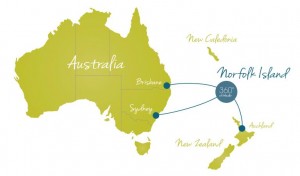About Norfolk Island
Norfolk Island is located in the South Pacific Ocean, 1,412 kilometres east of Evans Head in Australia. Its geographic coordinates are 29 02S, 167 57E. Travel times are two hours by air from Australia, and 1.5 hours from New Zealand. Land area is 34.6 square kilometres. The population of 1,795 (2011 Census – 951 Female, 844 Male) have English as their main languages. Norf’k, the language of the descendants of the Mutiny on the Bounty, is also spoken. About 40% of the population are descendants.
Norfolk Island has a fascinating history. Polynesian explorers were the first people to settle on the island around the 10th century AD but mysteriously disappeared by the 14th century. Two penal settlements followed with the most recent settlement starting in 1856. Learning more about this history is one reason why you should choose Castaway as your Norfolk Island accommodation for at least one of your Norfolk Island holidays.
Captain Cook was the first European to discover the island in 1774, and he named it for his British patron, the Duchess of Norfolk. Two years later the American Revolution began and Britain had to find new territories for the deportation of convicts. Drawing on Cook’s discoveries, Australia and Norfolk Island were selected and the First Fleet travelled to Australia in 1787, landing there on 26th January 1788.
Six weeks later, Norfolk was settled by a small band of convicts and free settlers to establish a ‘food bowl’ for the Australian settlement. While this first penal settlement was abandoned in 1814, a second penal settlement was re-established in 1825 and Norfolk Island was transformed into the legendary prison isle. This settlement was of the harshest kind, and remained so until 1855. A legacy of those times is the southern hemisphere’s best collection of convict-built Georgian buildings, many of which are still in use today.
Interestingly, today’s Norfolk Islanders can thank another infamous event in history for their presence on Norfolk. In 1788 HMV Bounty, captained by William Bligh, left England on a mission to gather breadfruit trees from Tahiti to provide food for slaves in the West Indies. A startling turn of events, including love affairs with Tahitian women and a mutiny on the Bounty, saw Fletcher Christian and his crew create a new life for themselves on Pitcairn Island along with a group of Tahitian women and men who had joined them. After the Bounty was burnt in Bounty Bay by Mathew Quintal, and after a violent and chaotic start, the Pitcairn community flourished as a devout and moral society, remaining undetected until an American whaling ship discovered the hideaway in 1808.
In 1854 Queen Victoria gave approval for the Pitcairn Islanders to move to Norfolk Island, whose days as a penal colony were coming to a fast end. Pitcairn could no longer sustain so many people. In June 1856, 194 people journeyed to Norfolk Island on HMS Morayshire, and about 40% of the island’s population today can trace their lineage back to the mutineers and their Polynesian partners.
During World War II an airport was constructed on Norfolk that was used to conduct surveillance missions in the South Pacific. This would eventually open up the island to more people to live and holiday here. Over 20 nationalities now call Norfolk Island home.
In 1979 the Australian Parliament passed the Norfolk Island Act 1979 that established the island as a self governing external territory of Australia, with extensive powers to manage its own affairs excepting coinage, euthanasia, and foreign affairs.

